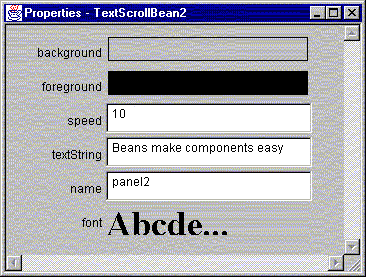TextScrollBean2.java
Here is the source code for TextScrollBean2.java:
import java.awt.event.*;
import java.awt.Graphics;
import java.awt.*;
import java.beans.*;
public class TextScrollBean2 extends Panel implements java.io.Serializable,
Runnable {
String text = null;
transient Thread kicker = null;
int speed=10;
int x = 0;
int y = 30;
int stringwidth;
int width = 250;
int height = 50;
FontMetrics fm;
// Offscreen graphics context and image to implement double buffering
transient Image offscreen;
transient Graphics goffscreen;
// Declare and instantiate a PropertyChange object
private PropertyChangeSupport changes =
new PropertyChangeSupport(this);
private VetoableChangeSupport vetos =
new VetoableChangeSupport(this);
public TextScrollBean2() {
text = "Beans make components easy";
setFont(new Font("TimesRoman",Font.BOLD,36));
start();
}
public Dimension getPreferredSize() {
return (new Dimension(width, height));
}
public String getTextString() {
return text;
}
public void setTextString(String newtext) {
text = newtext;
}
public int getSpeed() {
return speed;
}
public void setSpeed(int newSpeed) throws PropertyVetoException {
// tell vetoers about the change
vetos.fireVetoableChange("Speed", "" + speed, "" + newSpeed);
// Send change event to listeners when
// speed is changed
changes.firePropertyChange("Speed", "" + speed, "" + newSpeed);
speed = newSpeed;
}
// Add a listener. This will get called by the BeanBox
public void addPropertyChangeListener(PropertyChangeListener l) {
changes.addPropertyChangeListener(l);
}
// Remove a listener. This will get called by the BeanBox
public void removePropertyChangeListener(PropertyChangeListener l) {
changes.removePropertyChangeListener(l);
}
// Add a veto listener. This will get called by the BeanBox
public void addVetoableChangeListener(VetoableChangeListener l) {
vetos.addVetoableChangeListener(l);
}
// Remove a veto listener. This will get called by the BeanBox
public void removeVetoableChangeListener(VetoableChangeListener l) {
vetos.removeVetoableChangeListener(l);
}
// This method can be used to connect a Button to the
// TextScrollBean.startScrolling method
public void startScrolling(ActionEvent ex) {
kicker.resume();
}
// This method can be used to connect a Button to the
// TextScrollBean.stopScrolling method
public void stopScrolling(ActionEvent ex) {
kicker.suspend();
}
public void start() {
if(kicker == null) {
kicker = new Thread(this);
kicker.start();
}
}
public void stop() {
kicker = null;
}
public void run() {
while (kicker != null) {
try {
Thread.sleep(speed);
} catch (InterruptedException e) {
e.printStackTrace();
}
repaint();
}
kicker = null;
}
public void paint(Graphics g) {
update(g);
}
public void update(Graphics g) {
fm = g.getFontMetrics();
stringwidth = fm.stringWidth(text);
// Added double buffering to eliminate flashing
// Create an offscreen graphics context
if (goffscreen == null) {
offscreen = createImage(width,height);
goffscreen = offscreen.getGraphics();
}
// Paint to our offscreeen graphics context
goffscreen.setColor(getBackground());
goffscreen.fillRect(0,0,width,height);
goffscreen.setColor(getForeground());
goffscreen.drawString(text, x, y);
// Paint our offscreen image to the screen
g.drawImage(offscreen,0,0,this);
if (x <= (-stringwidth)) {
x=width;
} else {
x--;
}
}
}
|
In addition to what TextScrollBean1 does to act as a source of design-time events, TextScrollBean2 adds two properties: speed and text. Notice the fields, setter methods, and getter methods.
You should be able to package TextScrollBean2 into a bean. On the next page we will add a bit more to
TextScrollBeans2 and rename it as TextScrollBean - Hoque's full blown bean example. But first, look
at the properties of TextScrollBean2 in the beanbox. Notice the two properties in addition to
those of Panel and TextScrollBean1.



